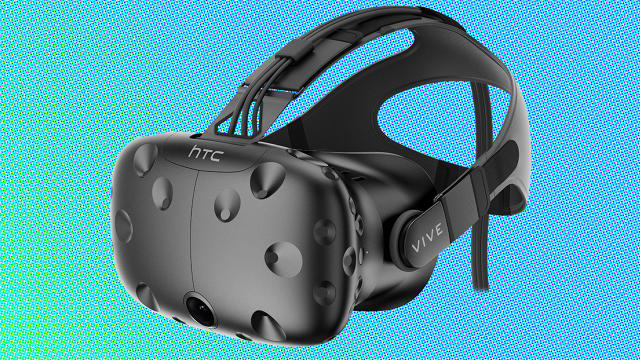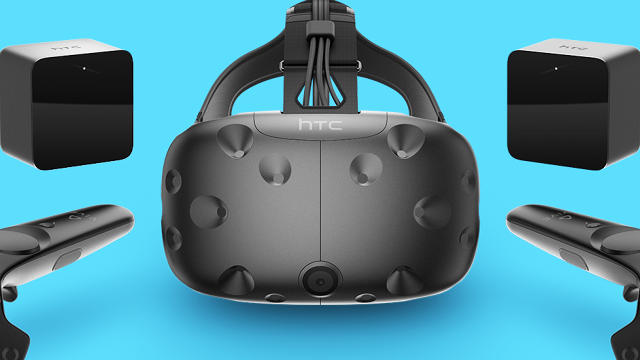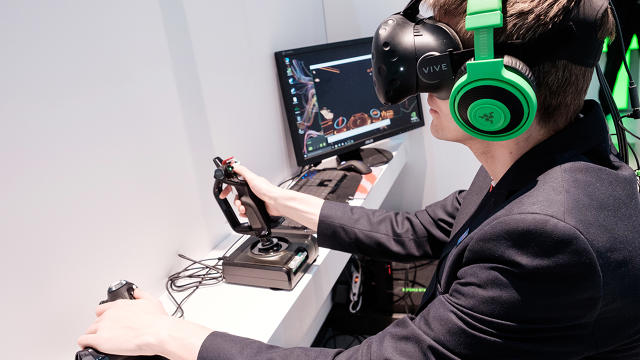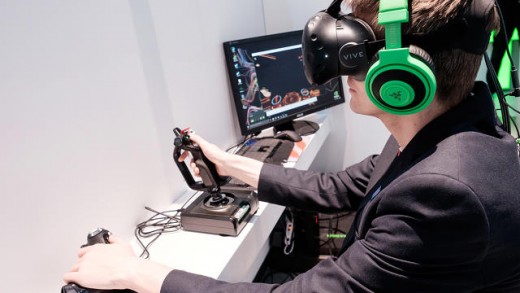HTC’s Vive Is Finally Here And It’s Very Compelling
When I bring my Samsung Gear VR to parties, I like to show people Wevr’s theBlu, a lovely virtual reality experience that puts you underwater where you can look around in 360 degrees at all kinds of marine life, including a massive blue whale that appears out of the deep and slowly but surely dominates your vision.
I’d rather show friends theBlu on HTC’s Vive, which begins shipping today. That’s because, while the mobile experience on the Gear VR is impressive, it limits you to what you can see by turning your head around. On the Vive, not only can you look around in 360 degrees, but you can also move your position in the scene, and even interact with the sea life thanks to two handheld controllers. It’s not scuba diving, but it’s a lot of fun.
To me, this is one of the best ways to define the difference between the just-fine VR experience offered by a midrange system like the Gear VR and the high-end experience available on the Vive and on systems like the Oculus Rift and Sony’s forthcoming $399 PlayStation VR.
For the last few days, I’ve been playing around with a review Vive. The arrival of the $799 device—along with last week’s launch of the $599 Oculus Rift—marks the point at which we can truly say that the full spectrum of consumer VR is here. From the low-end Google Cardboard to the Gear VR to the high-end systems, users can now pick the level of virtual reality they want, and can afford. No matter which they pick, they’re in for a treat.
It’s safe to say, though, that those who go with the Vive—or the Rift, though Fast Company has not yet reviewed the new system from Facebook-owned Oculus—will not regret their decision. Being able to physically move around and control things, thanks to what’s called room-scale VR, is worth the money.

Gaming-quality PC
In the early going, money is definitely going to play a factor in many VR-curious consumers’ decision-making. The Gear VR costs just $99, though it requires a high-end Samsung smartphone. But both the Rift and the Vive requires a gaming-quality PC, like the MSI rig Nvidia sent me for Vive reviewing purposes. That substantial additional cost—a minimum of $1,000 investment for those who don’t already have such a computer—is certainly going to deter some people. It’s hopeful, though, that over the next year, the price of compatible computers will drop, even as the VR hardware itself gets cheaper.
When you strap on the Vive, though, you can understand why all that power is needed. The Vive’s gorgeous graphics, thanks to Steam software from Valve, is very much high-end, and often quite impressive. Whether with photo-realistic games like The Lab or wonderful artistic experiences like Tilt Brush, the system offers a wide range of high-fidelity options.
Still, as you might expect at this stage in the VR era, games make up much of what’s available. The same is true on the other systems as well. Not being a gamer myself, I felt somewhat limited in what I could do with the Vive, and other non-gamers may well want to wait until there’s a much deeper roster of things to do. Interactive cinematic projects like Fox’s The Martian VR Experience are a very good start, but those are as yet few and far between.
I’ll defer to Vive reviews by more experienced gamers for a better examination of what the system offers in that realm.
Still, even some of the less intensive games I tried were compelling. Playing Cloudlands: VR Minigolf, I was quickly won over by how faithful the experience was to what you would expect from a miniature golf game. Using the Vive’s controller as a putter, it took me just minutes to achieve a level of skill that I was happy with, and when I have a little more time, I’d like to keep on playing, and improving my score.
One of the questions I get from friends who try VR for the first time—after they finish being amazed—is “what next?” There is, as yet, no killer app, despite those who say VR porn is just that. And for now, it’s likely that games will make up the bulk of what people do with systems like the Vive.
Nevertheless, all you have to do is spend a few minutes playing a wonderful art program like Tilt Brush—or Medium, for the Oculus Rift—to realize that the potential for non-gaming experiences is off the chart. It’s just a matter of time, and developer energy, before high-end VR systems, thanks in large part to positional tracking technology, let you travel wherever you want on Earth or play the role of just about anyone you could want to be.
This is especially true on systems like the Vive, Rift, and PlayStation VR, thanks to their ability to let you be an actual interactive participant in whatever experience you’re trying out.

Setup
After unpacking the Vive, I found an instruction sheet of sorts that promised it would take about 28 minutes to set up.
I’ll admit I was skeptical. Having played with a number of developer versions of the Vive, I didn’t fully believe HTC could have gotten the device ready for people like me to easily get up and running.
The trickiest part is that the Vive relies on two wall-mounted base stations that it uses to figure out where you are in physical space.
Given that I have a review Vive, I was reluctant to drill holes in my wall in order to mount them. Yet I discovered it was actually possible to simply place them on top of a wardrobe and another large piece of furniture, and it was good to go.
A few Windows PC-related issues aside—I’m a Mac user normally—and the Vive was up and running. I would imagine that if I can get to that point in more or less the 28 minutes HTC predicts, most people could do it in as much time, or even less.
The trick now for the Vive ecosystem, and that of the Rift, PlayStation VR, Gear VR, and any other VR system, is making sure that there is an ever-growing amount of content. Analysts predict that the VR content market will be worth $5.4 billion by 2025. For that to be true, developers need to keep pushing the boundaries, keeping up with hardware improvements, and giving users a reason to keep coming back.
The entire VR ecosystem is expected to hit $30 billion by 2020, and for that to be true, a whole lot of people are going to need to buy systems like the Vive and its competitors over the next few years. For now, the hardware companies are trying to manage expectations because they know that there aren’t going to be tens of millions of these devices sold overnight, especially when most people have still never even tried a VR experience.

Over the last year, I’ve become an evangelist for VR because I have been wowed again and again by a multitude of experiences. I’ve scaled Everest, I’ve been to Mars, I’ve been a multimedia, 3-D artist, and I’ve sunk putts. Although the Rift has probably gotten the most attention since it was first announced in 2012, I’d have to say that more people who know something about VR have been waiting to get their hands on the Vive.
Given the price of these systems, it’s unlikely that many people will buy both a Rift and a Vive, so early adopters are going to be choosing now that both are on the market—and with the PlayStation VR expected to go on sale this fall. Not having had the chance to spend extended time with the Rift yet, I’m loathe to say which one I’d pick.
But I can say with confidence that almost anyone who brings home a Vive will find themselves smiling an awful lot, and with a line of friends out the door eager to get a chance to dive into the immersive world of virtual reality that, after decades of promises, is finally making its way into our homes.








Fast Company , Read Full Story
(56)














